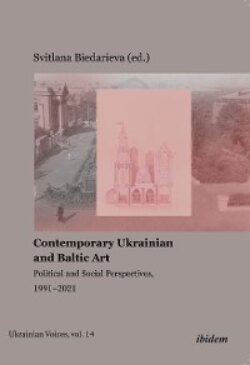Читать книгу Contemporary Ukrainian and Baltic Art - Группа авторов - Страница 15
На сайте Литреса книга снята с продажи.
Give Up the Ghost
ОглавлениеChange, as a fluctuation of the notions of belonging and identity and their political, personal, and physical crises, as well as a revisiting of social norms, relations, and structures through contemporary aesthetics, was at the core of the 13th Baltic Triennial titled Give Up the Ghost (2018).17 Staged as three separate chapters—not just in Vilnius, where it has taken place since the late 1970s, but also in Tallinn and Riga—the triennial’s geographic extension manifested the co-existence of difference. Although it was part of the program of nationally oriented centenary celebrations of all three Baltic states, instead of fixed concepts of identity and belonging, the exhibition invited its audience to think about these concepts through notions such as formless subjectivities, anti-categorization, fluidity, and multiplicity, since “they privilege forms of infiltration, displacement and hybridization, and operate as a lens through which to consider the unstable ground on which we stand as evidenced by moral, political and economic uncertainties of modern capitalist societies and the crisis in forms of knowledge and taxonomies.” (Honoré 2018, 8) Among various references, its artistic director Vincent Honoré highlighted a metaphor of a Creole garden introduced by the French Caribbean philosopher Édouard Glissant, to whom these gardens embodied a place of disorder, where things can co-exist yet avoid being in contradiction or opposition. In the context of the curatorial statement of the triennial, this metaphor allowed for fluid thinking, outside of fixed, straight, and binary forms, and questioned norms so that they migrate, evolve, change, and mutate. Not manifesting a direct political stance, the triennial clearly emphasized the wish to abandon any rigid structures in the contemporary world in times of the political, ecological, and migration crises and the alarming growth of nationalism and authoritarianism. It thus spotlighted tensions and contradictions in today’s society.
These principles, which aimed to deconstruct established social and political notions and power relations—or the “ghost,” whose presence, according to the triennial, is a disturbing phantom—appeared in the works in the exhibition indirectly, through artistic methodologies and aesthetics, often in alienated and abstract forms, with which their content and meaning were inextricably intertwined, activating “many kinds of relationships, affects and modes of embodiment, and receptivity.” (Honoré, 9) The global curatorial team of the triennial noted that along with themes of togetherness, individuality, identity, and the (performative) gesture, it explored the heritage and aspirations of the Baltics in the context of global and contemporary artistic discourses. Yet, in the expositions these aspirations remained elusive, as they were dominated by artists who were not related to the region and, also those coming from the Baltics, most were in fact based in Western metropolises. The global art language of these works was clearly embedded in Western-oriented perceptions.
One of the works that referred to the regional context and its fluctuating identities was a performance by Lithuanian artist Lina Lapelytė, who invited kokle (a traditional music instrument in Lithuania and Latvia) players from the national song and dance ensemble Lietuva to the exposition in Tallinn. Their performance created a contemporary soundscape, subverting the usual folkloric melodies for which this historic instrument is typically known. In her performance-based works, Lapelytė often explores issues of cultural identity, otherness, passage, and transition, or the feeling of nostalgia. She mixes contemporary forms of performativity with folk rituals, popular music, and opera, inviting amateur and professional musicians. In her work in the Baltic Triennial she also included the legacy of folk music, which, fused with contemporary hybridity, maintained complexity and heterogeneity rather than homogenous sameness.
A work that was even more characteristic of the biennial, and sought to deconstruct and decontextualize established fixed categories and closed structures, were the sculptural installations of the Paris-based Latvian artist Daiga Grantiņa. Formed from synthetic and natural materials, these objects created an impression of dystopian futuristic objects, which embody a condition of change, or a world that is forming or transforming. They could also be perceived as an extension and materialization of the artist’s thought process, which interacts with its viewers’ perceptions, moods, and imaginations, and were an example of the “radical openness” that embodies art’s capacity to constitute an alternative language beyond words and stories, and beyond mere representation, and thus has the potential to shape the world and create alternatives to the current state of affairs. (Klimašauskas 2019; Lāce 2019)
All three exhibitions, analyzed above, vividly revealed the approaches of contextualization and decontextualization of regional artistic geographies. In terms of the recent political and migration crisis, as well as discussing identity issues, they emphasized a transcultural and relational approach. However, also in a broader sense, they commented on challenges to look for new models that are no longer based on previous constructions of identities, but on their transformations that go beyond nationalism or regionalism. In these new models, still can correlated both the diversity and specificity of contexts and the plurality in terms of identities and artistic practices in the global age.
